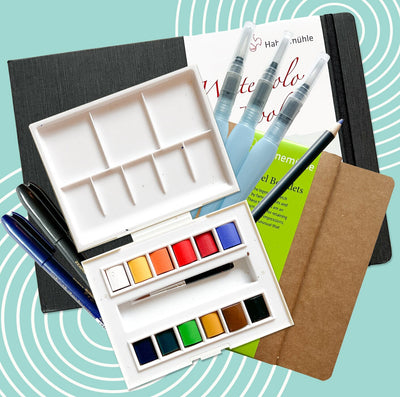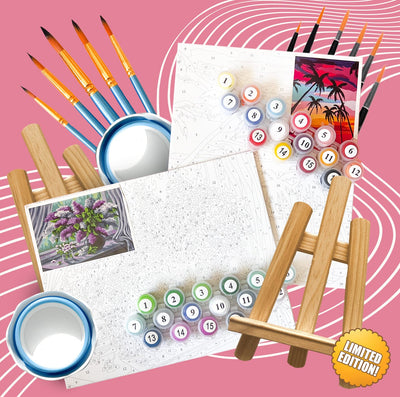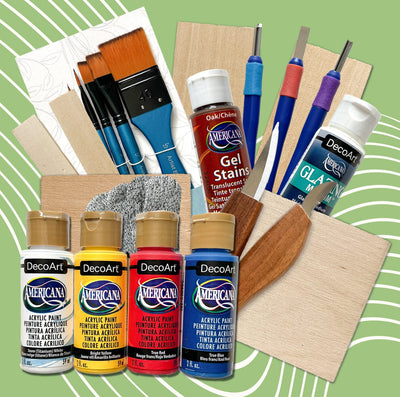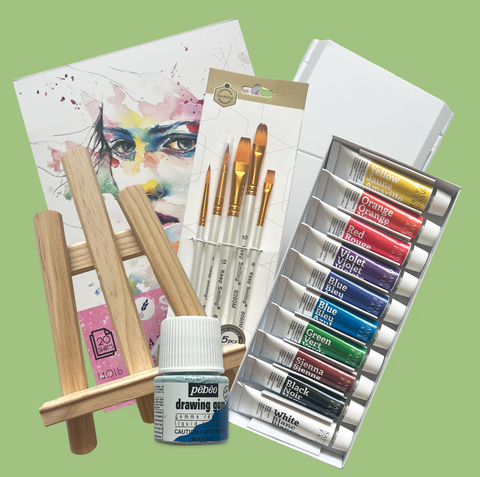Gouache vs. Watercolor: What's the Difference?
By Amy Hand
Hello, there arty pals!
We have to say; when we found out what was in this month’s box, we got very excited! Gouache is an incredible medium that is not as widely used as we think it should be, and we are here today to get you just as excited as we are.
Although some would consider gouache a modern medium, it has actually been around for twelve centuries! Evidence of its use has been found in paintings from Ancient Egypt. They were even used in illuminated manuscripts like the ones we looked at in last month’s blog. Nowadays, gouache is favored by artists, particularly illustrators, to create posters, illustrations, and graphic novels.
Due to their composition and how they are used, it's very common to get gouache and watercolors mixed up. So today, we are here to dissect what gouache is and what exactly the difference is between the two.
So if you’re ready to learn all about gouache and what makes it unique, let’s get into it!
What is Gouache, and How is it Made?
So, before we get into the differences between gouache and watercolor, we should get to know gouache a little bit better.
Gouache is a water-based paint that is highly pigmented and dries down completely matte. When the paint dries, it will be a slightly different shade than when it was wet, so using a swatch chart as a reference is an excellent way to know what you’re going to end up with. This will take some getting used to, but you know what they say; practice makes perfect!
You can buy gouache in tubes or palettes with prefilled pans, which is very similar to watercolor. If you use a palette, like the folding artist’s palette in this month’s box, you can fill the wells with paint straight from the tube or blend your own shades and close it up when you’re done. Then, when you are ready to paint again, you just need to open it, re-wet the paint, and you’re ready to go!
You can vary the amount of water you use, so the gouache applies more thickly thick acrylic or more sheer and watery like watercolors. Once you get the hang of it, gouache is a very versatile medium that lets you really flex your artistic muscles.
When it comes to the actual ingredients, gouache is very similar to watercolors.
The ingredients that go into making gouache are:
We will go into more detail about the role of chalk a little later.
The paint's consistency, whether in pan or tube form, depends on the ratio of binder to water. More dextrin will make it thicker, while most tubes of gouache have a 1:1 ratio of water to dextrin, making it squeezable.
Using water as a base makes it possible to rewet these paints over and over, preventing you from wasting any paint. However, be careful only to use a little water when working with gouache; a little goes a long way.
Gouache vs Watercolor
Now that we know all of that, we can get to the question of the day: what is the difference between gouache and watercolor?
There are a few key differences that are subtle but interesting:
Pigmentation
The first and the most noticeable difference is the pigmentation; there is a reason that gouache is often referred to as ‘opaque watercolors.’
Both paints have a very similar water and dextrin base, but their ratio of pigment to the base is very different, which makes the pigments stand out more. The pigment particles in gouache are also larger than in watercolors, making them more boldly pigmented.
These densely packed particles create a solid, opaque color when applied. On the other hand, watercolors have finer particles that are more dispersed, which gives you a sheer wash of color. The pigmentation of both these paints can be manipulated by varying the amount of water you use.
Transparency
The beauty of watercolors is in their transparency which can create beautifully blended gradients. When the paint is applied, you will be able to see the paper shine through, which gives it a slightly glossy and shimmering finish.
Conversely, gouache has the added ingredient of white chalk to obscure the paper below completely. This is how you get that beautiful matte finish and solid color.
This transparency really changes the way you can apply the paint. In watercolors, you need to apply the lighter values first and then move to dark as a lighter color will not show up on top of a dark one. Gouache is not restricted in the same way. Due to its opacity, light and dark colors can be easily applied on top of one another, as long as the top color is not too watery.
Some artists use both gouache and watercolor together to create a layered piece with both transparency and denser areas of solid pigment.
Drying Time
Gouache dries much faster than watercolors, making it quicker to work with. This drying time makes gouache ideal for large areas of solid color, while watercolors are better for blended gradients.
Even if one dries faster than the other, they are both very wet mediums. This means you need to be fussy about what paper to use, so it doesn’t buckle under all that water. The Smart Art cold press watercolor pad included in this box is 300gsm and absolutely perfect for this medium.
Detail Work
Since watercolors are so thin and watered down, it can be hard to render the smaller details of your piece in this medium. That’s where gouache comes in.
If you use just a little water and a small brush, you can easily pick out those small details in gouache without them blurring into one another.
At the end of the day, gouache and watercolors are two wonderful water-based mediums that can be used side by side to create beautifully layered art pieces. They set themselves apart from oils and acrylics with a water base that means no paint ever goes to waste, but they remain their own unique mediums with their own advantages.
We hope this little dive into the wonderful world of gouache has left you itching to dig into this month’s box and create some stunning art of your own. As usual, we can’t wait to see what you think of using gouache as your inspiration.





